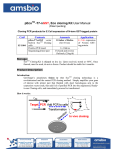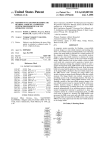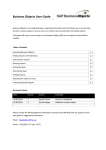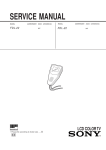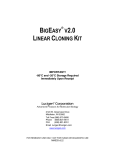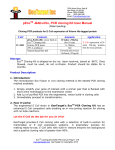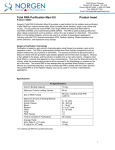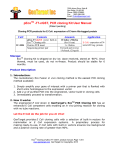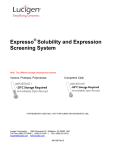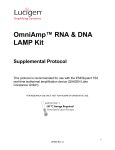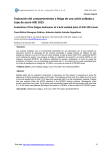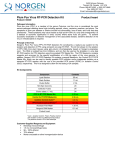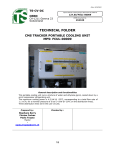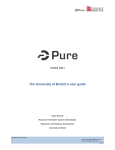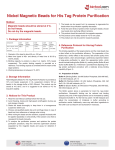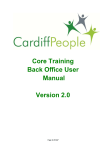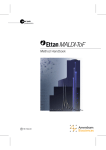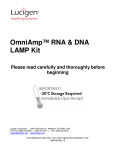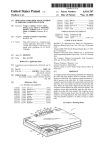Download SelecTEV™ Protease
Transcript
SelecTEV™ Protease FOR RESEARCH USE ONLY. NOT FOR HUMAN OR DIAGNOSTIC USE. Lucigen Corporation 2905 Parmenter St, Middleton, WI 53562 USA Toll Free: (888) 575-9695 | (608) 831-9011 | FAX: (608) 831-9012 [email protected] www.lucigen.com SelecTEV™ Protease Table of Contents Technical Support .................................................................................................................................. 2 Product Designations ............................................................................................................................. 3 Components and Storage ...................................................................................................................... 3 SelecTEV™ Protease Description ......................................................................................................... 3 Unit Definition ..................................................................................................................................... 4 Unit Assay Conditions ........................................................................................................................ 4 Recommended Conditions for Cleavage of a Fusion Protein ............................................................... 4 Removing SelecTEV™ Protease after Substrate Cleavage ................................................................. 4 SelecTEV™ Cleavage During Dialysis .................................................................................................. 5 SelecTEV™ Protease Cleavage Troubleshooting ................................................................................ 5 TEV Protease References ..................................................................................................................... 6 Online resources: ............................................................................................................................... 7 Technical Support Lucigen is dedicated to the success and satisfaction of our customers. Our products are tested to assure they perform as specified when used according to our recommendations. It is imperative that the reagents supplied by the user are of the highest quality. Please follow the instructions carefully and contact our technical service representatives if additional information is necessary. We encourage you to contact us with your comments regarding the performance of our products in your applications. Thank you. Lucigen Technical Support Email: [email protected] Phone: (888) 575-9695 Product Guarantee: Lucigen guarantees that this product will perform as specified for one year from the date of shipment. Please avoid using reagents for longer than one year from receipt. 2 MA157 Rev. B SelecTEV™ Protease Product Designations SelecTEV™ Protease is supplied with SelecTEV™ 20X Buffer and 100 mM DTT. The catalog numbers are listed below. Product Kit Size Catalog Number 1,000 Units 30810-1 5,000 Units 30810-2 SelecTEV™ Protease Components and Storage SelecTEV™ Protease and the supplied components must be stored at -20°C. SelecTEV™ Protease consists of the following components: Component Part Number 1,000 Units 5,000 Units F833167 100 µL 100 µL x 5 SelecTEV™ 20X Buffer F883093-1 1.0 mL 1.0 mL x 5 100 mM DTT F853091-1 500 µL 500 µL x 5 SelecTEV™ Protease (10 U/µL) SelecTEV™ Protease Description SelecTEV™ Protease is an improved form of Tobacco Etch Virus (TEV) protease that has been engineered to be more specific, active, and stable than the native protease. SelecTEV™ Protease recognizes the seven amino acid sequence Glu-Asn-Leu-Tyr-Phe-Gln˅Gly and closely related sequences. SelecTEV protease cleaves between the Gln and Gly residues. This seven amino acid sequence is rarely found in proteins, making SelecTEV™ Protease an ideal choice for tag removal from fusion proteins. The optimal temperature for cleavage is 30°C, however the enzyme is active over a wide temperature range (4 – 30°C) and pH (6.0 – 8.5) to accommodate your specific protein. Following digestion, SelecTEV™ Protease is easily removed from the cleavage reaction by affinity chromatography using the polyhistidine tag at the N-terminus of the protease. SelecTEV™ Protease is purified from E. coli by affinity chromatography using the polyhistidine tag and is 90% pure when visualized on an SDS-PAGE gel. 3 MA157 Rev. B SelecTEV™ Protease Unit Definition One unit of SelecTEV™ Protease cleaves ≥85% of 3 µg of control substrate in 1 hour at 30°C. Unit Assay Conditions The cleavage assay is performed in 1X SelecTEV™ Buffer (50 mM Tris-HCl, pH 8.0, 0.5 mM EDTA) and 1 mM DTT with 10 units enzyme and 30 µg control substrate at 30°C for 1 hour in a total volume of 100 µL. Recommended Conditions for Cleavage of a Fusion Protein An example of a cleavage experiment with 10 units of SelecTEV™ Protease is shown below. Optimization of the cleavage conditions may be necessary depending on the protein of interest. While cleavage occurs optimally in the provided SelecTEV™ Protease Buffer at 30°C, SelecTEV™ Protease is active between 4 – 30°C and pH 6.0 – 8.5. Note: A precipitate may be observed after thawing of the 20X SelecTEV Buffer. Warm to 37°C and vortex to bring back into solution prior to use. 1. Add the following to a microcentrifuge tube. Volume, µL Component X 5 1 1 Y 100 Fusion Protein SelecTEV™ 20X Buffer DTT, 100mM SelecTEV™ Protease, 10 U/ µL Water Total Volume Final Concentration/ Amount 30 µg 1X 1 mM 10 U N/A 2. Incubate the reaction at 30°C for at least 1 hour. 3. Stop the reaction by adding SDS sample buffer (62.5mM Tris-HCl pH 6.8; 2% SDS; 5% βmercaptoethanol or 0.1M DTT; 25% glycerol; 0.01% Bromophenol Blue) and heating at 95°C for 5 minutes. 4. Analyze 10 µL from step 2 by SDS-PAGE gel. The percent protein cleavage is determined by analyzing the amount of uncleaved protein remaining after digestion. After evaluating the initial results, the cleavage reaction may be optimized for your specific protein by adjusting the amount of SelecTEV™ Protease, incubation temperature, and/or reaction time. Removing SelecTEV™ Protease after Substrate Cleavage SelecTEV™ Protease contains a polyhistidine tag at its N-terminus. After cleavage of the fusion protein, you may remove SelecTEV™ Protease from the cleavage reaction by affinity 4 MA157 Rev. B SelecTEV™ Protease chromatography on an immobilized metal affinity chromatography (IMAC) resin such as Ni-NTA (Qiagen), TALON® (Clontech), or His-Select® (Sigma). Perform the binding and elution as described in the resin manufacturer’s protocol. The cleaved native protein will be in the flow-through fractions (as long as the cleaved protein does not contain a histidine tag) and the protease will remain on the resin. Notes: Imidazole remaining in the sample could prevent the polyhistidine tag on SelecTEV from binding to the IMAC resin. Remove or dilute imidazole prior to IMAC purification. Many IMAC resins do not tolerate 1 mM DTT. Dilute the sample in column binding buffer or remove DTT prior to purification. SelecTEV™ Cleavage During Dialysis The cleavage reaction can be performed during buffer exchange by dialysis. Conditions may be adjusted from those recommended above. In general, use 1 µL SelecTEV (10 U) for every 10 µg of fusion substrate. If dialysis is carried out at 4 °C, an overnight (≥ 16 hours) reaction time is recommended. SelecTEV™ Protease Cleavage Troubleshooting There are a variety of reasons that SelecTEV™ Protease may not cleave a particular substrate as expected. Refer to the troubleshooting table below to address your potential issue. Problem Probable Cause Potential Solution SelecTEV™ Protease is not cleaving my fusion protein. The cleavage recognition site is not accessible by SelecTEV™ Protease. Modify the reaction conditions. Variables may include time, temperature, salt concentration, and/or detergent level. SelecTEV™ Protease is not captured on the IMAC resin. Cleavage reaction is inhibited by components in the sample. Possible inhibitory components include imidazole or detergents. Binding of the SelecTEV™ Protease to the affinity resin is inhibited by the presence of imidazole. See references below (TEV Protease Reference section) for additional information on possible modifications of the reaction conditions. Add a linker between the TEV cleavage site and the protein of interest. Remove inhibitory components from sample using dialysis or other methods prior to cleavage. Dialyze your protein out of imidazole-containing buffer during SelecTEV cleavage of your fusion protein. 5 MA157 Rev. B SelecTEV™ Protease Problem Probable Cause Potential Solution The capacity of the resin is exceeded. Test larger amounts of resin. Remember to take into consideration any Histagged fragments released from the fusion protein by SelecTEV cleavage, which will also bind to the resin. SelecTEV™ Protease is demonstrating nonspecific cleavage, as evidenced by the presence of more cleavage products than expected. DTT or EDTA in the sample strips metal from IMAC resin. Dilute or dialyze the cleavage reaction into buffer without DTT or EDTA before loading sample on column. There may be additional motifs in your fusion protein that SelecTEV Protease recognizes as cleavage sites. Examine your substrate’s amino acid sequence for potential TEV Protease recognition sites. Mutation of these sites may be required. TEV Protease References Kapust, R. B., Tözsér, J., Fox, J. D., Anderson, D. E., Cherry, S., Copeland, T. D., and Waugh, D. S. (2001). Tobacco etch virus protease: Mechanism of autolysis and rational design of stable mutants with wild-type catalytic proficiency. Prot. Eng. 14: 993-1000. Kapust, R. B., Tözsér, J., Copeland, T. D., and Waugh, D. S. (2002a). The P1' specificity of tobacco etch virus protease. Biochem. Biophys. Res. Commun.294: 949-955. Lundbäck, A.K., Van Den Berg, S, Hebert, H, Berglund H., Eshaghi, S (2008). Exploring the activity of tobacco etch virus protease in detergent solutions. Analytical Biochemistry. 382: 69-71. Mohanty, A.K, Simmons, C.R, Wiener, M.C. (2002). Inhibition of tobacco etch virus protease activity by detergents. Protein Expression and Purification. 27: 109-114. Phan, J., Zdanov, A., Evdokimov, A. G., Tropea, J. E., Peters, H. P. K., Kapust, R. B., Li, M., Wlodawer, A., and Waugh, D. S. (2002). Structural basis for the substrate specificity of tobacco etch virus protease. J. Biol. Chem. 277: 50564-50572. Tozser, J., Tropea, J. E., Cherry, S., Bagossi, P., Copeland, T. D., Wlodawer, A., and Waugh D. S. (2005). Comparison of the substrate specificity of two potyvirus proteases. FEBS J. 272: 514-523. Van den Berg, S., Lofdahl, P. A., Hard, T., and Berglund, H. (2006). Improved solubility of TEV protease by directed evolution. J. Biotechnol. 121: 291-298. 6 MA157 Rev. B SelecTEV™ Protease Online resources: http://mcl1.ncifcrf.gov/waugh_tech/faq/tev.pdf http://www.cardiff.ac.uk/biosi/staffinfo/ehrmann/tools/Recognition.htm Notice of Limited Label License, Copyright, Patents, Warranties, Disclaimers and Trademarks Copyright© 2015 by Lucigen Corp. All rights reserved. Lucigen and SelecTEV are registered trademarks of Lucigen Corporation. Lucigen’s products are sold for research use only and are not to be used in humans or for medical diagnostics. Lucigen’s liability with respect to any SelecTEV product is limited to the replacement of the product. No other warranties of any kind, expressed or implied, including without limitation, any implied fitness for any particular use, are provided by Lucigen. Lucigen is not liable for any direct, indirect, incidental or consequential damages arising out of or in connection with the use or inability to use any of its products. Some applications in which Lucigen enzymes can be used may be covered by other patents issued and applicable in the United States and certain other countries. Because purchase of this product does not include a license to perform any patented application, users of this product may be required to obtain a patent license depending upon the particular application in which the product is used. It is the sole responsibility of the buyer to ensure that use of the product does not infringe the patent rights of third parties. Limited Label License Lucigen does not encourage or support the unauthorized or unlicensed use of third party intellectual property. It is the sole responsibility of the buyer to ensure that use of the product does not infringe the patent rights of third parties. If the purchaser is not willing to accept these use limitations, Lucigen Corporation is willing to accept return of the product for a full refund. For information on obtaining a license to use this product for purposes other than those permitted above, contact Lucigen Corporation, 2905 Parmenter St., Middleton, WI 53562. Email: [email protected]. Phone: 608-831-9011. Fax 608-831-9012. The consideration paid for this product grants a Limited License to use the product pursuant to the terms set forth in this Limited Label License. Academic, Not-for-Profit and For-Profit institutions acquire certain limited nontransferable rights with the purchase of this product (see below). By use of this product, you accept the terms and conditions of the Limited Label License. The purchase price of this product includes limited, nontransferable rights to use only the purchased amount of the product and only as described in the product’s User’s Manual. This limited license specifically excludes manufacture of SelecTEV Protease or any derivatives thereof. The buyer cannot modify this product for any purpose without express written consent of Lucigen Corporation. Lucigen Corporation reserves all other rights; in particular, the purchaser of this product may not transfer or otherwise sell this product or its components or derivatives to a third party, and no rights are conveyed to the purchaser to use the product or its components or derivatives for commercial purposes. The buyer may transfer information or materials made through the employment of this product or its components to a scientific collaborator, provided that such transfer is not for 7 MA157 Rev. B SelecTEV™ Protease commercial purposes, and that such collaborator agrees in writing (a) not to transfer such materials to any third party, and (b) to use such transferred materials and/or information solely for research and not for commercial purposes. “Commercial purposes” includes any activity for which a party receives consideration and may include, but is not limited to, (1) use of the product or its components or derivatives in manufacturing, (2) use of the product or its components or derivatives for diagnostic purposes, (3) use of this product or materials made therefrom to provide a service, information, or data to a third party in return for a fee or other consideration, or (4) resale of the product or its components or derivatives, whether or not such product or its components or derivatives are resold for use in research. Lucigen Corporation will not assert a claim of infringement against the buyer of this product provided that none of this product, or any of its components, or any claim in the foregoing patent or patent applications was used in the manufacture of a product for commercial purposes. Academic, Not-for-Profit, and For-Profit institutions must obtain a separate license from Lucigen Corporation to use this product for any purpose other than those permitted above. 8 MA157 Rev. B








